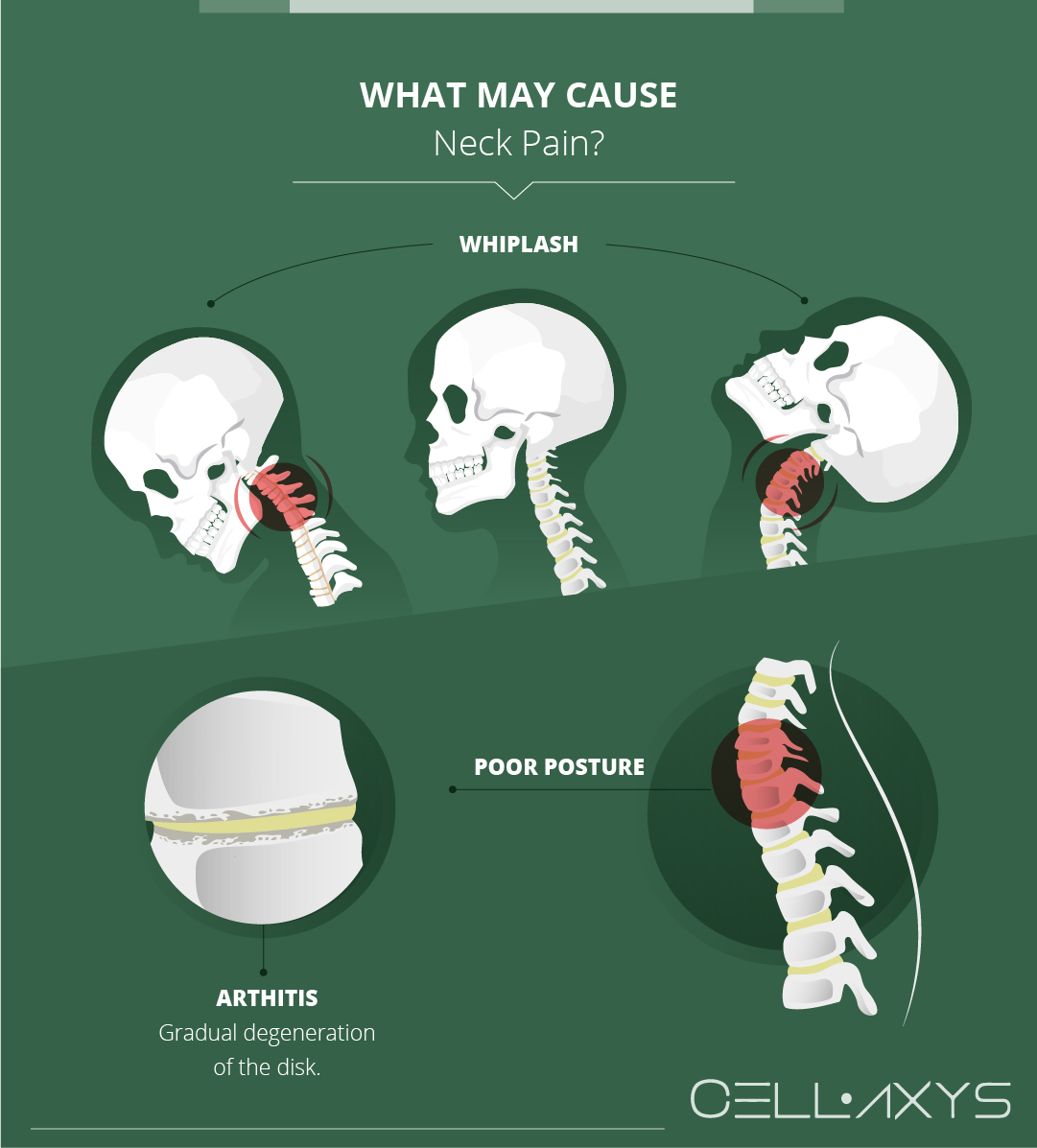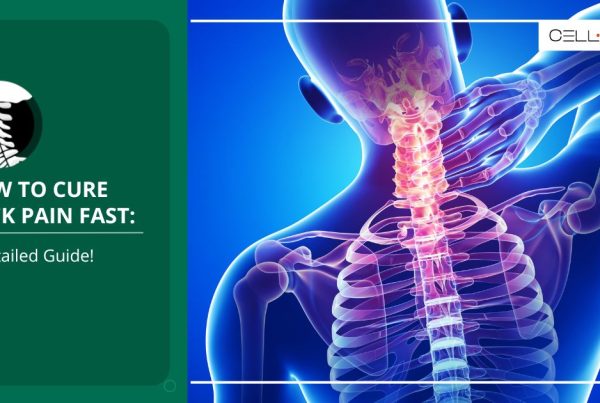Published on: November 15, 2019 | Updated on: August 29, 2024
Pain in the neck can be anywhere from inconvenient to completely debilitating and include a wide range of symptoms.
The structures of the neck are extremely important to the wellness and function of our lives. Pain or injury in this area can also lead to other symptoms throughout the body, including tingling, dizziness, weakness, and nausea.
Do you have neck pain?
Fill out the form below to schedule your FREE virtual consultation
Structures of the Neck and Spine
There are three sections of the spine: cervical (neck), thoracic (torso), and lumbar (lower back). The cervical spine is the section that exists in the neck. This section of the spine is responsible for supporting the head, lower spine, and shoulder area.
The spine also protects the spinal cord, which contains many of the nerve endings that send signals from the brain to the rest of the body. These nerve endings are an important part of the entire body’s ability to perform most activities.
Despite the protection that the spine offers, nerve endings can still be susceptible to damage or injury. When nerves are damaged, signals can no longer be sent in the same way, causing a myriad of symptoms.
Nerve damage can have many causes as well. There are many moving structures that could contribute to different forms of damage. These structures include muscle, tendons, cartilage, vertebrae, nerves, and spinal discs. Each has a list of things that can go wrong, depending on an individual’s activity level, history of injury, or degenerative illness.
What May Cause Neck Pain?

The many small parts of the neck leave it susceptible to several different injuries. The causes listed below are the most common, but it is important to get examined to ensure that the cause of neck pain is diagnosed correctly. Common causes of neck pain are:
- Injury: traumatic injuries, especially those that involved a form of whiplash, can contribute to neck pain after the injury and later in life. Some injuries may heal on their own, but they can sometimes heal in an incorrect way that leads to neck pain later in life.
- Arthritis: arthritis is characterized by the gradual degeneration of the structures in the body. Osteoarthritis in the cervical spine typically affects the articular cartilage between the bones of the vertebrae, causing them to rub against one another and cause damage. This damage can not only cause pain but can also change the structure of the joint to the point where it is pinching or causing damage to nearby nerves.
- Poor Posture: consistently maintaining the neck in a poor position can lead to neck problems and pain later in life.
The aspect of neck pain that can lead to nausea involves the condition called cervical vertigo. Cervical vertigo is caused by a nerve or blood vessel being pinched in the neck. This can lead to nerve signals not being sent where they need to go and disrupted oxygen flow.
This condition can also impact the inner ear, causing the sensation of dizziness or nausea. Cervical vertigo and neck problems, in general, have a long list of potential symptoms.
Signs and Symptoms of Neck Pain
The predominant symptom of an underlying issue in the neck is pain. This pain can start off dull and increase in intensity over time or can be a pain that comes on suddenly or only during certain activities.
The degree of pain that an individual feels can vary greatly. It is recommended to see a doctor after an injury or when the pain impacts daily activities. This could include disrupted sleep, inability to perform simple tasks, or difficulty exercising. Symptoms that may be associated with neck pain are:
- Dizziness
- Nausea
- Weakness
- Sensitivity
- Tingling sensation in the neck, shoulders, or back
Nausea that is associated with neck pain is often related to other symptoms such as dizziness or loss of balance. It is important to describe the symptoms in as much detail as possible when consulting with a doctor.
Diagnosing Neck Pain
The first step in diagnosing neck pain involves a consultation with a doctor. One of the best ways to ensure an accurate diagnosis is, to be honest about all the symptoms experienced and when. Some symptoms that may seem unrelated could be important information for doctors and lead to a correct diagnosis.
Doctors may perform tests during your consultation in order to help pinpoint the source of the pain. These tests may involve turning the head, moving the eyes, and searching for sensitivities by touching the neck. Initial testing may indicate certain conditions, but doctors often use the help of certain technology in order to diagnose a condition:
- MRI: Magnetic Resonance Imaging allows doctors to see a picture of the soft tissues in the neck, which could reveal a pinched or damaged nerve and blood vessel.
- CT Scan: this form of imaging lets doctors see if there is an issue within a specific cross-section of the neck.
- X-Ray: this type of imaging of the bone structures may reveal skeletal abnormalities causing pain and discomfort.
- EMG: electromyography tests the speed at which nerve signals are conducted throughout the body. This may reveal nerve damage, which sends signals more slowly than a healthy one.
Once a diagnosis has been made, doctors can begin to devise a treatment plan that is unique for each patient.
Conventional Treatments of Neck Pain and Associated Symptoms
Treating neck pain often begins with simply taking over-the-counter pain medication (NSAIDs) and temporarily eliminating painful activities. Applying heat or cold to the area can help with pain management as well.
It may also be recommended that a patient take anti-nausea or anti-dizziness medication. Like NSAIDs, these over-the-counter nausea treatments can be found in most drug and big box stores.
If the initial steps of treatment fail to reduce pain, there are other treatment options that doctors may recommend to alleviate symptoms. These include:
- Avoid strenuous activity: if there is a motion or activity that aggravates neck pain, it is generally suggested to stop the activity or consult a physical therapist about how to do it in a less painful way.
- Sleep positions: certain sleep positions can result in reduced pain. A doctor or physical therapist can recommend ways to adjust sleeping positions to ensure greater comfort.
- Practice good posture: good posture can contribute to pain management and reduce the chance of back complications in the future.
- Physical therapy: the practice of physical therapy generally seeks to ease symptoms of an injury while simultaneously strengthening the muscles surrounding it.
- Massage therapy: manual manipulation of the musculoskeletal tissues by a massage therapist can alleviate pain and inflammation in the affected area.
- Corticosteroid injections: by injecting a powerful anti-inflammatory solution into the site of pain, doctors can relieve pain symptoms. These injections should be monitored closely, as they can lead to damaged tissue if overused.
- Prescription medication: some doctors may prescribe medication to ease the symptoms of pain, nausea, or dizziness depending on the severity of symptoms.
- Surgery: if neck pain persists throughout the treatment process, surgery may become necessary. Many different types of surgery exist to help neck pain, so it is best to consult a doctor about the options.
Many treatment options exist and can be used in combination based on a patient’s individual needs. Another important treatment option that should be considered is regenerative medicine.
Regenerative Medicine for Neck Pain and Associated Symptoms
Regenerative medicine may be a good treatment option for sufferers of neck pain. It can help with pain and the symptoms that come with it. These treatments help heal nerves that have been damaged, as well as muscle or other tissue injuries.
Regenerative medicine involves using a patient’s own cells to amplify their body’s healing abilities. These forms of therapy work with cells that already exist in the body or “autologous” tissues to help an injury heal.
There are two forms of regenerative medicine offered at CELLAXYS:
- Cell-Based Therapies: this form of therapy takes a patient’s healthy cells from different body parts, processes them, and then reinjects them into the injury site. They are mostly extracted from the adipose (fat) tissue or bone marrow. When the doctor opts for the adipose tissue, the process is called a Minimally Manipulated Adipose Tissue transplant. When they take cells from the bone marrow, the process is called Bone Marrow Concentrate (BMAC). These cells contain properties that are ideal for healing an injury or degeneration.
- Platelet-Rich Plasma (PRP) Therapy: this form of therapy begins with a simple blood draw. The doctor isolates platelets from the patient’s plasma and then reinjects them into the patient’s injury site. Platelets contain proteins and 10 Growth Factors to boost the body’s natural healing process. They also send chemical signals to attract healing cells from the blood and produce fibrin, a sticky web-like structure that supports new tissue development. Platelets in the injury site increase the number of healing properties and speed up the body’s healing.
Cell-based therapies are completed within 1.5 to 2 hours, while PRP takes about 45 minutes. PRP and cell-based therapies typically involve imaging techniques such as ultrasound or live X-Ray (fluoroscopy) to guide the needle to where it needs to go.
These are outpatient procedures, meaning you can go home after the treatment. Some patients report feeling some pain at the injection site, which usually goes away in a matter of days.
Sources
Footnotes
- Lee YZ, Lee RQ, Thinn KK, Poon KH, Liu EH. How patients fare after anaesthesia for elective surgery: a survey of postoperative nausea and vomiting, pain and confusion. Singapore medical journal. 2015;56(1):40.
- Gawel MJ, Rothbart PJ. Occipital nerve block in the management of headache and cervical pain. Cephalalgia. 1992;12(1):9-13.
- Shafar J. Stiff-neck syndrome. British Medical Journal. 1978;1(6111):511.
- Ma RC, Tsang MW, Ozaki R, Tong PC, Cockram CS. Fever, headache, and a stiff neck. The Lancet. 2004;363(9424):1868.
- Mariani E, Pulsatelli L. Platelet concentrates in musculoskeletal medicine. International journal of molecular sciences. 2020;21(4):1328.
References
- What causes headache, dizziness, fatigue, and neck pain?. Medical News Today. Accessed 9/5/2023.
- Nausea Or Vomiting, Stiff Neck And Upset Stomach. MedicineNet. Accessed 9/5/2023.
- Neck pain. Health Direct. Accessed 9/5/2023.
CELLAXYS does not offer Stem Cell Therapy as a cure for any medical condition. No statements or treatments presented by Cellaxys have been evaluated or approved by the Food and Drug Administration (FDA). This site contains no medical advice. All statements and opinions are provided for educational and informational purposes only.
Dr Pouya Mohajer
Author
Pouya Mohajer, M.D. is the Director of Spine and Interventional Medicine for CELLAXYS: Age, Regenerative, and Interventional Medicine Centers. He has over 20 years of experience in pain management, perioperative medicine, and anesthesiology. Dr. Mohajer founded and is the Medical Director of Southern Nevada Pain Specialists and PRIMMED Clinics. He has dedicated his career to surgical innovation and scientific advancement. More about the doctor on this page.
Dr Pejman Bady
Contributor
Dr. Pejman Bady began his career over 20 years ago in Family/Emergency Medicine, working in fast-paced emergency departments in Nevada and Kansas. He has served the people of Las Vegas as a physician for over two decades. Throughout this time, he has been met with much acclaim and is now the head of Emergency Medical Services in Nye County, Nevada. More about the doctor on this page.









